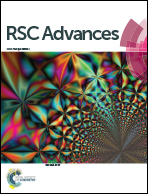Porous Fe0/C ceramsites for removal of aqueous Pb(ii) ions: equilibrium, long-term performance and mechanism studies†
Abstract
This study reports the equilibrium, long-term performance and mechanisms in removing Pb(II) ions by metallic iron/carbon (Fe0/C) ceramsites (FCC). The Pb(II) removal equilibrium data was analyzed using the Langmuir, Freundlich and Dubinin–Radushkevich isotherms. At the FCC dosage of 1.14 g L−1, 95.97% of Pb(II) ions were removed from 50 mg L−1 Pb(II) solution at initial pH 6.0. The Langmuir isotherm could fit well with the data at initial pH 3.0 with a maximum monolayer adsorption capacity of 112.36 mg g−1 at 25 °C, while the data obtained at initial pH 6.0 could be described by the Freundlich model, indicating multilayer adsorption of Pb species on the FCC. Column tests demonstrated that FCC achieved the highest Pb(II) removal of 65.86% after 12 days' run compared to 32.35% for Fe0/activated carbon couples and only 1.24% for activated carbon. The X-ray diffraction and X-ray photoelectron spectroscopy analysis revealed that the PbO (dominant Pb species), Pb0, asisite and plumbojarosite appeared after Pb(II) removal. Scanning electron microscopy with energy dispersive X-ray spectroscopy showed that PbO particles with numerous structures were deposited on the FCC surface in a high amount. The decrease of the Fe/C mass ratio from 7.5 : 1 to 0.298 : 1 revealed that microscale Fe0 could been readily corroded by forming galvanic couples between Fe0 and carbon. The mechanisms of Pb(II) removal by the FCC were proposed.



 Please wait while we load your content...
Please wait while we load your content...